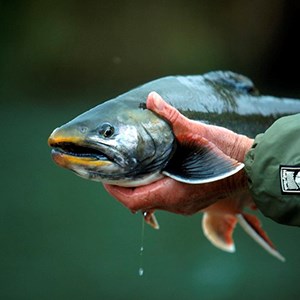Genetic mapping of Arctic charr – an important step for Swedish aquaculture

The Swedish breeding program for Arctic charr has been run successfully for almost forty years. Historically, breeding has been based on classic selection methods where breeding fish are selected according to their characteristics and known family ties. Now a first step has been taken to update the Swedish breeding program with genomic methods. The results show good genetic status for the farmed charr and give hope for the future.
Genetic mapping lays the foundation for a sustainable breeding program
The Swedish breeding program for Arctic charr (Salvelinus alpinus) has been going on for almost 40 years and has been an important factor behind the success of farming charr in Sweden. To date, the breeding program has included classical quantitative genetics, where breeding fish are selected according to physical characteristics and known family ties. In recent years there have been major advances in genetic research, which can simplify and refine breeding and facilitate the sustainable development of Arctic charr farming.
At the research station in Kälarne, Jämtland, a first step has now been taken to update the breeding program through the introduction of genomic methods (the use of the genetic code in the genome), for example to identify extra valuable individuals.
New genomic methods contribute to great progress
It is still relatively uncommon to use genomic methods to guide the selection decisions in fish breeding programs. Extensive and detailed mapping of the genome is costly and resource-intensive, but technological advances in recent decades have led to new opportunities, at least for those species that have a large-scale industry attached to them. The use of unique genetic markers, which can be linked either to an individual's origin and relationship or to its physical characteristics, has led to major advances in breeding of Atlantic salmon, for example in Norway.
Recently, new genomic methods have also been developed, which provide more cost-effective but less comprehensive mapping of the genome, for example the so-called ddRAD sequencing (double digest restriction site associated DNA sequencing). Another advantage of the new methods is that they do not require a complete reference genome to be able to be used for breeding purposes.
SLU and Vattenbrukscentrum Norr AB conduct joint research
Rresearchers at SLU, together with Vattenbrukscentrum Norr AB, have initiated a genomic mapping of the farmed charr through ddRAD sequencing. The Formas-funded project NextGenCharr aims to introduce the latest technology for genetic mapping, so-called next generation sequencing (NGS), in the Swedish breeding program for charr. The Kolarctic CBC project ARCTAQUA aims, among other things, to investigate the importance of genetics for fertility and egg survival for charr. One of the biggest bottlenecks for a sustainable breeding program and for a continued expansion of charr farming in Sweden is the low fish egg survival - a problem that the breeding program in its current form has not overcome.
So far, DNA samples from 1730 charrs originating from the Swedish breeding program have been analyzed, in order to evaluate their genetic diversity, inbreeding rate and possible links to the impaired egg survival perceived by many fish farmers.
The results show good genetic status in our farmed charrs
Within the framework of the breeding program, the degree of inbreeding based on pedigree has previously been estimated at an average of 6% after 40 years of breeding. Through the genomic analysis that has now been done, it has been possible to determine the actual inbreeding rate to an average of 7%, with a spread from 3% to 18% between the various individuals in the herd. Inbreeding cannot fully be avoided within breeding and an average inbreeding of 6-7% falls within what is considered acceptable for a program that has been going on for so long. The new information about the actual inbreeding rate in individuals makes it possible to avoid the fish that otherwise would have contributed more to an increased inbreeding within the breeding group.
The results show a good genetic status of the breeding fish and there are no signs that the breeding program is on its way into a dead end. However, continued monitoring of genetic diversity will benefit the long-term sustainability of the breeding work. The analyzes did not show any connection between inbreeding rate and egg survival. This indicates that the low reproductive success seen among charr in Swedish aquaculture is probably not a result of the breeding work. Further analyzes are currently being carried out to find genetic markers for fertility in male charrs.
Overall, the work with these new methods contributes to creating good conditions for sustainable development for Swedish-bred charr.
Link to the publication
A genomic-based vision on the genetic diversity and key performance traits in selectively bred Arctic charr (Salvelinus alpinus)
Authors: Christos Palaiokostas, Anam Anjum, Henrik Jeuthe, Khrystyna Kurta, Fernando Lopes Pinto, Dirk Jan de Koning.
Contact
Department of Animal Breeding and Genetics, Department of Animal Breeding and Genetics, Applied Genetics